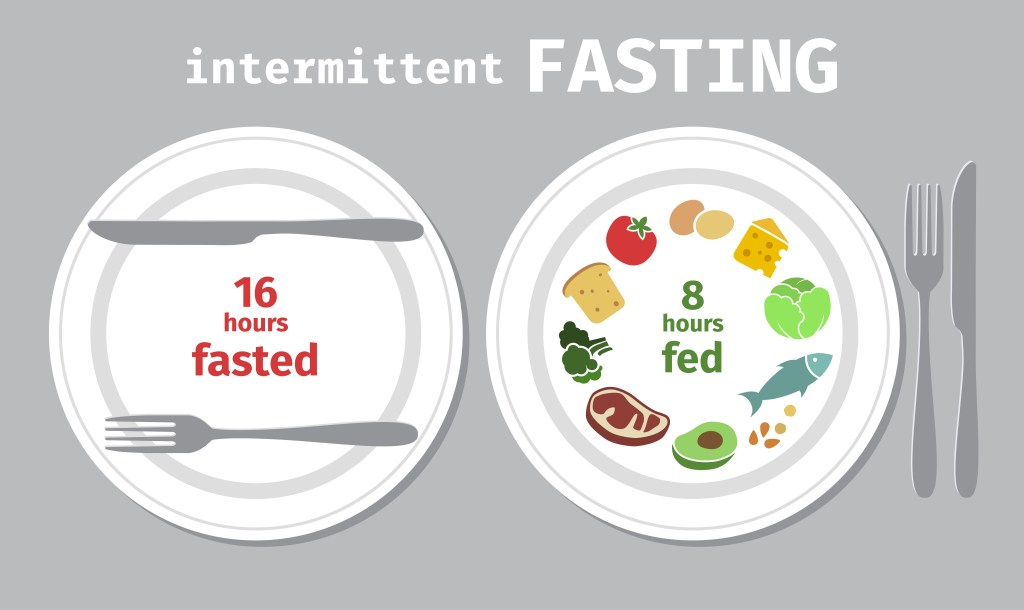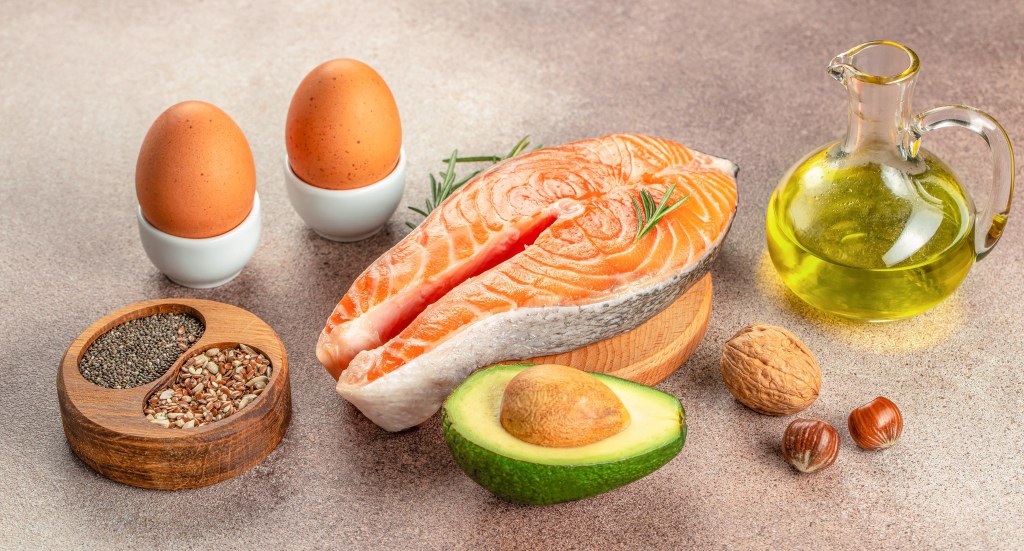At a glance
Intermittent fasting is an eating pattern that alternates between periods of fasting and eating to help the body transition into a fat-burning state. It supports metabolic health by lowering blood sugar and insulin levels, promoting ketosis, and encouraging the body to utilize stored fat as an energy source. This approach may also help improve cognitive function, insulin sensitivity, and overall well-being when paired with nutrient-rich foods and proper hydration.
What is intermittent fasting, and should you consider doing it?
The 16:8 fast is a popular intermittent fasting pattern that triggers profound metabolic changes that can help your body burn fat stores, increase insulin sensitivity, lower blood pressure, and enhance cellular regeneration.
Learn how to start intermittent fasting and discover why restricting your calorie intake for prolonged periods can unlock your health goals.
What is intermittent fasting?
Intermittent fasting is an eating pattern that alternates between fasting and time-restricted eating periods.
There are several different types of intermittent fasting patterns:
- The 16:8 intermittent fasting plan involves 16 hours of fasting followed by an eight-hour eating period.
- The alternate-day fasting plan is characterized by fasting every other day, where you consume no calories or drastically reduce your calories consumed to around 500 to 600 calories.
- The 5:2 fasting approach involves eating normally for five days a week and restricting calorie intake to around 500 to 600 calories on two non-consecutive days.
“Because of its simplicity, many people find the 16:8 eating pattern easy to follow and sustainable in the long run,” explains Dr. Berg. “It’s the most popular intermittent fasting plan and a perfect addition to a keto lifestyle.”
Watch the video below to learn important intermittent fasting basics for beginners.
Benefits of intermittent fasting
An intermittent fasting eating pattern triggers profound metabolic changes and pushes your liver to convert stored body fat into energy.
As your body breaks down fats, large amounts of ketones are released. Ketones are a metabolic by-product of fat-burning and a highly-efficient energy source for your cells, tissues, and organs.
When ketones enter your circulation and start to fuel your cells, you reach a metabolic state known as ketosis. Ketosis doesn’t just support weight loss and help maintain a healthy body weight–it also has impressive benefits for your health and longevity.
Intermittent fasting works by keeping blood sugar and insulin levels low, which has a wide range of hormonal and metabolic benefits, especially in combination with a low-carb diet like Healthy Keto®.
Research published in Clinical Nutrition and Metabolic Care found that intermittent fasting can help significantly improve insulin resistance, a metabolic imbalance linked to diabetes, high blood pressure, and excessive abdominal fat, also known as belly fat.1
Fasting helps with brain health, too! It has shown to improve cognitive function and memory recall.
In addition, there is evidence that continuous calorie restriction triggers autophagy, a cellular process of breaking down and recycling damaged or dysfunctional cellular components.
While intermittent fasting has many health benefits, it may not be suitable for everyone.
Individuals with a history of eating disorders, those who struggle to gain weight, and pregnant or breastfeeding mothers should avoid continuous calorie restriction or discuss fasting with a healthcare provider.

How to get started
The key principle of intermittent fasting is to avoid food and calorie-containing beverages during your fasting period, which forces your metabolism to tap into stored body fat to generate energy.
If you’re contemplating intermittent fasting for weight loss, the urge to immediately practice prolonged fasts to maximize your results may be strong. However, fasting for too long, too quickly, is the most common mistake when starting intermittent fasting.
Your metabolism needs time to adapt to fasting. Easing slowly into an intermittent fasting schedule lets your body get used to metabolic and hormonal changes and allows you to tweak your lifestyle to time-restricted eating.
It’s generally recommended to start with a 14-hour fast followed by a ten-hour eating window, and gradually prolong your fasting periods. While some individuals can achieve a 16:8 fasting pattern within a week or two, others may take a month to reach this goal.
As you extend your fasting periods, you can skip breakfast and cut the number of meals from three to two. This is typically the point when most people see significant changes in their well-being, body weight, and energy levels.
Another critical aspect of successfully transitioning into an intermittent fasting routine is breaking snack habits. Snacking, even on low-calorie or healthy foods, during your fasting window can break your fast and reduce the metabolic benefits of calorie restriction.
While it may seem challenging to stay clear of snacks during the early stages of fasting, your hunger sensations and cravings will diminish once your body adapts to burning body fat as a fuel source.

Tips for intermittent fasting beginners
Intermittent fasting has helped millions of people worldwide to take charge of their well-being, improve a wide range of health issues, and achieve a healthy body weight.
However, reaching your health goals with intermittent fasting requires more than simply restricting your eating times. It’s equally important to consider what you eat.
Consuming processed foods high in sugar, carbs, and harmful trans fats during your eating window can significantly slow down or even prevent fasting success.
Here are four practical tips for intermittent fasting beginners.
1. Eat nutrient-rich foods
Limiting meals and eating fewer calories can lead to a lower intake of essential nutrients, and it’s important to consume nutrient-rich foods daily to avoid nutrient deficiencies that may impact your health.
Combining intermittent fasting with a healthy diet low in carbs, high in healthy fats, and rich in nutritious vegetables, organic dairy, and grass-fed meats is an excellent way to promote optimal nutrition while maintaining fat burning.
2. Drink plenty of fluids and replenish electrolytes while fasting
Fasting stimulates the depletion of glycogen, which can cause fluid loss and electrolyte imbalances linked to an increased risk of kidney stones.
Drinking plenty of fluids and replenishing electrolytes while fasting is crucial for fasting success and minimizes side effects such as headaches, lack of energy, and brain fog.
Here are calorie-free drinks that you can enjoy during your fasting window:
- Water
- Black coffee
- Herbal tea
- Black and green tea
- Unsweetened flavored seltzer water
- Sparkling water
- Diluted apple cider vinegar
Drinking lemon water is an excellent fasting hack to support kidney function. Lemons are a rich source of acetic acid, a natural acid that stops dietary oxalates from forming calcium oxalate crystals, the leading cause of kidney stones.
You can also add ginger and cinnamon to your tea or coffee to add extra flavor without breaking your fast.
In addition, it’s crucial to replenish electrolytes by adding a high-quality electrolyte powder (sugar-free) to your water while fasting.
Electrolyte imbalances and dehydration are among the most common reasons for keto-flu symptoms and are linked to weakness, lightheadedness, muscle cramps, and headaches. Water fasting isn’t recommended because it can increase your risk of electrolyte imbalance.

3. Consume enough healthy fats
Although it may seem counterintuitive, not eating enough fat can slow down weight loss.
Following a nutritious high-fat diet like Healthy Keto can speed up your body’s adaptation to fasting and amplify the benefits of time-restricted eating.
Restricting carbs and sugars and eating plenty of healthy fats on the keto food list helps to keep your metabolism in fat-burning mode during your eating window.
Maintaining ketosis enhances the metabolic advantages of fasting, maximizes fat burning, and has been found to significantly improve body composition in overweight adults.
In addition, eating a high-fat meal before starting your fasting period increases satiety and curbs hunger and cravings, which explains why individuals on a high-fat diet typically achieve longer fasting periods.
4. Bulletproof coffee
Drinking bulletproof coffee while fasting promotes ketosis and fat burning and can help extend your fasting periods.
Bulletproof coffee is a keto-friendly beverage containing black coffee, medium-chain triglycerides (MCT), and unsalted butter. Although it’s not calorie-free, bulletproof coffee has no carbs and won’t impact blood sugar or insulin levels, keeping your metabolism in a natural fasting state.
MCTs are a type of fatty acid that’s rapidly converted into ketones, which promotes ketosis and supports steady energy levels during your fasting period.
Many people who practice intermittent fasting use bulletproof coffee for a welcome caffeine boost while fasting and report that they can fast for more extended periods.
This anecdotal evidence is backed by science. Research published in Fats and Satiety suggests that MCTs are the most satiating fatty acids and help diminish hunger during periods of continuous energy restriction.2
Key takeaways
- Intermittent fasting is an eating pattern that alternates between periods of fasting and eating, allowing the body to utilize stored fat for energy.
- Common fasting schedules include the 16:8 method, alternate-day fasting, and the 5:2 approach, with the 16:8 plan being the most popular for its simplicity and sustainability.
- This practice supports a healthy metabolism by lowering blood sugar and insulin levels, promoting ketosis, and enhancing fat burning, ultimately promoting overall well-being.
FAQ
1. How do you start intermittent fasting?
Starting intermittent fasting is easy. Slowly extend your overnight fast by gradually pushing back breakfast until you feel comfortable reducing your meals from three to two per day.
As your body adapts to prolonged periods of caloric restriction, hunger and cravings will diminish, which helps to reach your desired fasting schedule.
2. How many hours a day should I do intermittent fasting?
The 16:8 schedule–fasting for 16 hours followed by an eight-hour eating window–is one of the most popular intermittent fasting plans.
The 16:8 intermittent fast is sustainable and has been linked to various health benefits such as weight reduction, improved metabolic health, and better blood sugar regulation.
3. What does intermittent fasting actually do?
Restricting calorie intake for extended periods forces your body to break down stored body fat to generate energy. This promotes weight loss, enhances metabolic health, and supports balanced hormone levels.
Most people notice improved energy levels, better sleep, and mental clarity after adapting to an intermittent fasting eating plan.
4. What am I allowed to eat during intermittent fasting?
While it’s generally recommended to restrict all solid foods while fasting, there are a few exceptions. Celery and cruciferous vegetables such as kale, broccoli, collard greens, and cabbage won’t raise your blood sugar or insulin levels, keeping your metabolism in a natural fasted state.
Medium-chain triglycerides (MCTs) are a type of fatty acid found in coconut oil that won’t disrupt ketosis. However, it’s important to remember that your liver prioritizes the metabolism of dietary fats before breaking down body fat. Consuming too much fat during your fast can potentially halt weight loss.
5. What am I allowed to drink during intermittent fasting?
Water, black coffee, herbal teas, black and green tea, unsweetened flavored seltzer water, sparkling water, and lemon water are all fasting-friendly beverages that can help you stay hydrated during your fasting periods.
6. How do you do intermittent fasting for weight loss?
A 16:8 intermittent fasting schedule combined with a nutritious high-fat diet like Healthy Keto® helps maintain ketosis during your eating window, which is an excellent approach to maximize weight loss. The easiest way to start intermittent fasting is to skip breakfast and have your first meal at lunchtime.
7. How long must you do intermittent fasting to see health benefits?
How long it takes to see intermittent fasting benefits depends on your overall diet, health status, and metabolism. However, most people notice an improvement in energy levels, better sleep, and weight loss within the first month of practicing intermittent fasting.
8. Is it better to fast for 12 or 16 hours?
Fasting for 16 instead of 12 hours allows for longer fasting periods and extends the time your metabolism relies on stored body fat as the primary energy source. This typically enhances fat burning, improves insulin sensitivity, and is more likely to stimulate autophagy.
9. What is fasting, and how do you do it?
Fasting means you voluntarily abstain from food and calorie-containing beverages for dedicated fasting periods.
Intermittent fasting involves cycling between periods of eating and fasting, typically 16 hours of fasting followed by an eight-hour eating window. Most people extend their overnight fasting period by skipping breakfast and consuming lunch and dinner during their eating window. Other types of fasting include 24-hour fasts and 48-hour fasts.
10. What are the basic rules of intermittent fasting?
The basic rules of intermittent fasting are slowly transitioning into your chosen fasting schedule and consistently following your fasting routine.
During fasting, avoid eating food and only drink calorie-free beverages such as water, black coffee, or herbal teas to push your metabolism to use body fat as an energy source.
11. How long is it safe to fast for?
Practicing short fasts, such as 16:8 intermittent fasting or occasional 24-hour fasts, is generally considered safe for most people. However, fasting periods longer than 24 hours can carry risks and may not be suitable for everyone. It’s essential to consult with a healthcare professional to evaluate your overall health before starting fasting for multiple days.
12. Why do people do fasting?
While some people fast for spiritual and cultural reasons, others practice fasting to achieve a healthy weight, improve well-being and energy levels, and lower the risk of metabolic diseases.
13. What are the best hours to do intermittent fasting?
The best hours for intermittent fasting depend on your preferences and daily routine. Most people find it convenient to fast overnight and through the morning, have their first meal around lunchtime, and resume their fast after dinner.
14. How much weight can you lose in a month with intermittent fasting?
While weight loss depends on many factors, including your health status, age, and metabolism, it’s not uncommon to lose between six to eight pounds per month with intermittent fasting.
Sources
- https://www.ingentaconnect.com/content/wk/cocnm/2016/00000019/00000004/art00011 ?
- https://www.ncbi.nlm.nih.gov/books/NBK53550/ ?


















